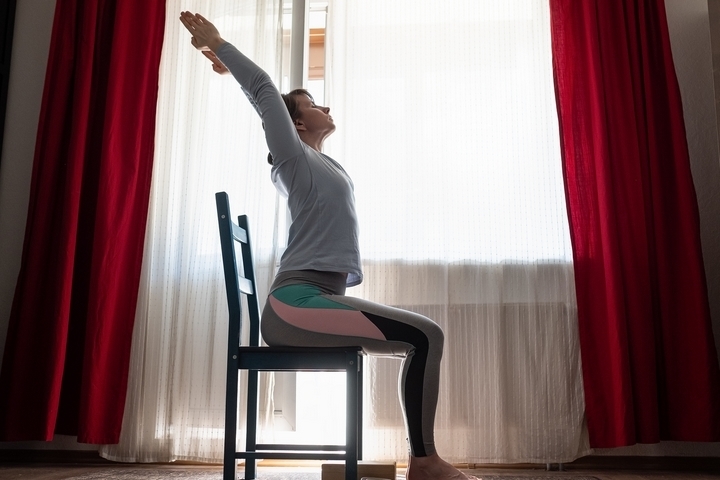You have the sacroiliac joints between the sacrum and ilium bones in the pelvis. They are responsible for absorbing shock through movement and stability while pushing off when walking by transferring force between your legs and trunk.
Issues like repetitive stress or a sudden injury can cause these joints to get inflamed and cause pain in your buttocks, hips, lower back and groin, making sitting very uncomfortable. With medication, chiropractor visits and exercise, you can stabilize these joints and ease pain. However, what can you do while waiting for inflammation to go down?
Here is a guide on how to sit with SI joint pain:
1. Relax your hip flexors
 Your hip flexors are a group of muscles that assist in moving your legs and knees towards your body. When tight, they pull on the SI joints and cause pain during sitting because of their upright posture support, so it’s important to stretch them gently to reduce the tension.
Your hip flexors are a group of muscles that assist in moving your legs and knees towards your body. When tight, they pull on the SI joints and cause pain during sitting because of their upright posture support, so it’s important to stretch them gently to reduce the tension.
A massage ball or release tool will effectively apply gentle pressure to the hip flexors, so they don’t cause added irritation to the SI joint.
2. Have good posture
 Posture is important while sitting because your SI joint helps stabilize your upper body and transfers motion to the lower body. Reach the top of your head towards the ceiling to bring your pelvis into a neutral position. Make sure not to arch or round out your spine. Lift and expand your chest as you take a breath and lower your shoulders so they are relaxed.
Posture is important while sitting because your SI joint helps stabilize your upper body and transfers motion to the lower body. Reach the top of your head towards the ceiling to bring your pelvis into a neutral position. Make sure not to arch or round out your spine. Lift and expand your chest as you take a breath and lower your shoulders so they are relaxed.
Keep your knees apart to distribute the weight more evenly and have your sit bones flat on the chair while keeping the tops of your hips level. It is also helpful to sit forward on the chair, so your knees are away from the front of your seat. This will keep your pelvis from tilting backwards. Bring your feet out, so your ankles are in front of your knees and keep your feet flat on the floor.
A good posture supports your body’s natural alignment and removes the pressure off your SI joint.
3. Tailor’s position
 When you need to sit, it can be on the floor or another flat surface. The tailor position is like when you were a kid and sat criss-cross applesauce. This is where your legs are crossed in front of you, so your feet are under your thighs. It is much easier when you are young and limber but is beneficial for SI joint pain because it aligns your pelvis into a neutral position and reduces the stress on the SI ligaments.
When you need to sit, it can be on the floor or another flat surface. The tailor position is like when you were a kid and sat criss-cross applesauce. This is where your legs are crossed in front of you, so your feet are under your thighs. It is much easier when you are young and limber but is beneficial for SI joint pain because it aligns your pelvis into a neutral position and reduces the stress on the SI ligaments.
Make sure your seat bones are flat on the surface or floor, and bring your chest up while relaxing your shoulders. If you are at work, you can practice this position on a break or use it at home for longer periods to relieve pain.
For an added stretch, grab your knees and pull your body forward to increase the stretch in the hips and lower back. Keep your knees apart and try to push them towards the ground as you do this.
4. Take standing breaks
 Finding the right position to ease the pain in your SI joints is important, but any seated position held too long can hurt. You need to take a break from it every 1/2 house and stand for 5 minutes. This will relieve lower back pain and engage your muscles and joints together. You can also go for a short walk to exercise the joints.
Finding the right position to ease the pain in your SI joints is important, but any seated position held too long can hurt. You need to take a break from it every 1/2 house and stand for 5 minutes. This will relieve lower back pain and engage your muscles and joints together. You can also go for a short walk to exercise the joints.
5. Seated exercises
 While seated, you can also practice some effective chair exercises to help with SI joint pain. They will strengthen muscles and reduce stiffness in the area.
While seated, you can also practice some effective chair exercises to help with SI joint pain. They will strengthen muscles and reduce stiffness in the area.
- Backbend: You can do this exercise by sitting on the edge of the seat while keeping your hands on your lower back and feet flat on the floor. As you inhale, gently push your lower back out and look up at the ceiling as you arch your back and exhale. Then grab the back of the chair and bring your shoulder blades back as you push your chest out and hold for up to 5 seconds. Do both these stretches 3-5 times.
- Cat-Cow Stretch: This stretch will work on your back muscles and core while sitting. Put your feet flat on the ground and your hands on your thighs. As you inhale, arch your back and open your chest while lifting your chin. Then exhale and round your back while drawing your chin towards your chest. This is a slow, flowing exercise you can repeat five times.
- Leg Raises: Leg raises are quick and effective when sitting on a chair. Simply keep your feet flat on the ground and alternate raising each one about 4 inches off the ground. Hold it for 10 seconds and switch to the other foot. Do this 7-10 times.
There are other effective SI joint exercises your chiropractor or physiotherapist can give you to strengthen your lower back and reduce inflation while sitting down.
Even while you are dealing with this ailment, you need to be able to sit down at work and rest. Use these tips to ease the discomfort and work towards your recovery from your SI joint pain.

